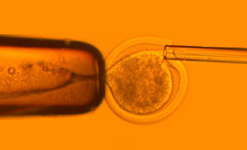U.S. Scientists To Begin Human Clone Farms For Stem Cell HarvestingScientists in U.S. to Attempt Human Cloning South Koreans FakedBloomberg Apr. 20, 2006 |
Popular 
Report: Blinken Sitting On Staff Recommendations to Sanction Israeli Military Units Linked to Killings or Rapes

America Last: House Bill Provides $26B for Israel, $61B for Ukraine and Zero to Secure U.S. Border

'Woke' Google Fires 28 Employees Who Protested Gaza Genocide

Bari Weiss' Free Speech Martyr Uri Berliner Wants FBI and Police to Spy on Pro-Palestine Activists

John Hagee Cheers Israel-Iran Battle as 'Gog and Magog War,' Will Lobby Congress Not to Deescalate
  April 13 (Bloomberg) -- American scientists plan to create stem cells that have a genetic makeup identical to that of living human adults, a feat that Korean scientists falsely claimed they accomplished last year. April 13 (Bloomberg) -- American scientists plan to create stem cells that have a genetic makeup identical to that of living human adults, a feat that Korean scientists falsely claimed they accomplished last year.U.S. researchers at Harvard University and in California said they first will create ``cloned'' human embryos in the lab by combining women donors' egg cells with DNA provided by other adults. The scientists will then isolate and extract stem cells from the embryos. The stem cells are critical to research on diabetes, Parkinson's disease, and other disorders, the scientists said. Research groups, including companies such as Geron Corp. of Menlo Park, California, will try to grow replacement tissue from the stem cells for use in medical therapies. ``For this class of disorders, we really don't have a lot of other avenues available'' for research, said Kevin Eggan, a cloning expert and molecular biologist at Cambridge, Massachusetts-based Harvard. He and other scientists discussed cloning plans at a science conference in Cambridge last week. Scientists previously have extracted human stem cells from unused embryos given to research labs by fertility clinics. The new experiments would break scientific ground as the stem cells would come from laboratory-made embryos created with the same genetic identity as the DNA donors. Seeking Ideas News of the research may draw protests from those who say it is wrong to create embryos that are destroyed during the removal of the stem cells. Procuring the egg cells isn't a simple matter either, the researchers said. By law, the eggs must be donated, not bought. Donors typically undergo days of treatments that can make recruiting women difficult, researchers said. Creating human stem cells from cloned embryos is critical to advancing the understanding of intractable brain disorders, such as Alzheimer's disease, that debilitate millions of Americans, said Lawrence Goldstein, 50, who leads one of the research teams at the University of California in San Diego. ``We're suffering from a shortage of rigorous ideas about what's happening to function in the human brain in these diseases,'' Goldstein said April 5 at the stem-cell conference. Stem cells in the embryo mature into cells that form the basis of all human organs. Scientists hope to use the extracted stem cells to grow human tissue, such as neurons, that might help them understand and treat brain disorders, strokes or spinal cord injuries. Eggan of Harvard said his goal is to grow cells in a lab dish to probe how people get type 1 diabetes, an immune attack that stops the pancreas from making insulin. Researchers eventually hope to treat patients by giving them insulin-making pancreas cells grown from stem cells. South Korea Visit Eggan, 32, visited the lab of Hwang Woo-Suk last year to learn techniques the South Korean said he had developed for producing embryos containing the DNA of volunteers. Hwang, who led the Seoul National University stem-cell laboratory, said he had created a method that required relatively few donated eggs, and promised to share the technique with others. ``I would have trusted him with my wallet,'' Eggan said of Hwang after meeting him last year. ``He projected this air of expertise and trustworthiness that exists with few people.'' Suspicions about Hwang's work arose last November when women said they had been paid for the eggs used by the Korean. The fraud was confirmed in January when investigators weren't able to find the stem cells Hwang said he had made. The hoax meant scientists had yet to figure out how to transplant human DNA into egg cells, said George Daley, 45, a Harvard researcher with a lab at Children's Hospital in Boston. ``We're now probably two years behind where we'd hoped to be,'' Daley said in an interview April 5. $100,000 Eggs Harvard's program has been examined and cleared by three ethical review committees and two institutional review boards that oversee human research, Douglas Melton, a Harvard stem cell researcher who works with Eggan, said at the conference. While fertility clinics pay as much as $100,000 for egg donations, Melton must conform to Massachusetts law that prohibits paying for eggs for cloning experiments. ``This is going to be tissue donation by compassionate people who want to cure these diseases,'' Melton, 52, said in an interview. That restriction alone may be enough to halt the research, said Robert Lanza, medical director of Advanced Cell Technology Inc., a Worcester, Massachusetts-based biotechnology firm. Before Massachusetts last year passed the law prohibiting payment for eggs donated for science, he paid donors about $4,000 and still was unable to get many eggs. Disentangling Funds The donation process takes an average of 56 hours in the clinic for hormone injections, frequent ultrasound imaging exams and tests for diseases such as HIV and hepatitis. Women also undergo psychological testing to determine their motives for donation, as well as a painful egg collection procedure, Lanza said. ``I personally feel uncomfortable about someone going through such a painful procedure with no compensation for time,'' Lanza said April 7. U.C. San Francisco researchers are also seeking permission to get egg donations, officials there said last week. Disentangling private from federal dollars has been extremely difficult, Eggan said. Harvard spent hundreds of thousands of dollars to audit Melton's support, ensuring that his embryonic stem cell work funded by such private groups as New York-based Juvenile Diabetes Research Foundation, received no money from the U.S. National Institutes of Health, the collaborators said. Melton's main laboratory, which does receive NIH funding, comprises some 4,000 square feet where at least 20 postdoctoral students, undergraduates and technicians work. The location of his privately funded lab in an unmarked basement is kept secret because of the university's concern that it might attract protests or violence. Reporters recently toured the building on the condition that they not reveal its location. `There's nothing about the research I do that should be done behind closed doors,'' he said. ``It's perfectly ethical and has an honorable goal.'' |



